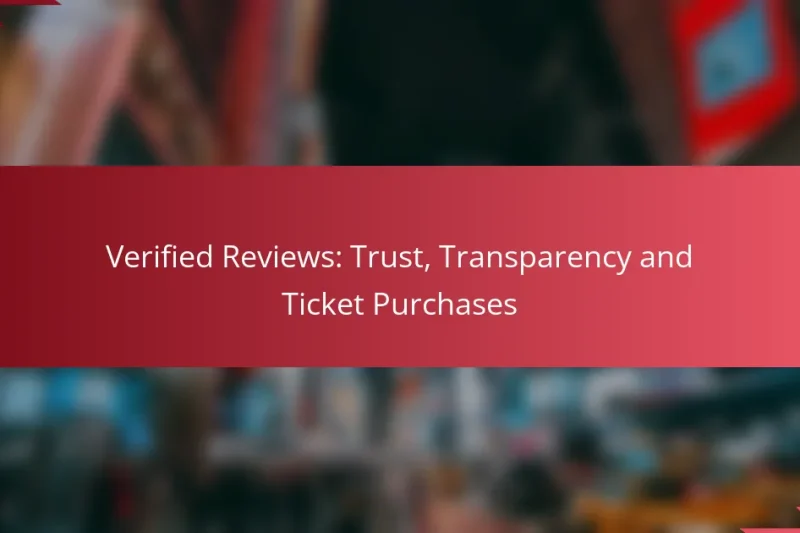Verified reviews play a crucial role in enhancing trust and transparency in ticket purchases by offering … Verified Reviews: Trust, Transparency and Ticket PurchasesRead more
Customer Reviews and Ratings
Customer reviews play a crucial role in shaping consumer decisions by offering valuable insights into product quality and user experiences. By understanding the perspectives of others, potential buyers can better assess whether a product aligns with their expectations and needs. Choosing the right platform for gathering these reviews is essential for businesses to connect with their target audience effectively.
Social Media: Research, Reviews and Ticket Booking Services
Social media plays a pivotal role in enhancing ticket booking services by boosting visibility and enabling … Social Media: Research, Reviews and Ticket Booking ServicesRead more
Customer Feedback: Comparison, Insights and Booking Platforms
Customer feedback platforms are essential tools for businesses looking to gather and analyze insights from their … Customer Feedback: Comparison, Insights and Booking PlatformsRead more
Constructive Feedback: Leaving Reviews and Enhancing Ticket Experiences
Leaving reviews plays a crucial role in enhancing ticket experiences by offering valuable feedback to event … Constructive Feedback: Leaving Reviews and Enhancing Ticket ExperiencesRead more
User-Generated Content: Reliability, Trustworthiness and Ticket Booking
User-generated content plays a crucial role in the ticket booking process, offering insights from real travelers … User-Generated Content: Reliability, Trustworthiness and Ticket BookingRead more
Influencer Reviews: Impact, Trust and Buying Decisions
Influencer reviews play a crucial role in shaping consumer perceptions and driving purchasing decisions by fostering … Influencer Reviews: Impact, Trust and Buying DecisionsRead more
How can customer reviews impact buying decisions?
Customer reviews significantly influence buying decisions by providing insights into product quality and user satisfaction. Prospective buyers often rely on the experiences of others to gauge whether a product meets their needs and expectations.
Influence on consumer trust
Customer reviews build consumer trust by offering authentic feedback from real users. When potential buyers see positive reviews, they are more likely to feel confident in their purchase, while negative reviews can raise red flags about product reliability.
To enhance trust, businesses should encourage satisfied customers to leave reviews and respond to negative feedback constructively. This engagement shows that the brand values customer opinions and is committed to improving its offerings.
Effect on conversion rates
Positive customer reviews can significantly boost conversion rates, often increasing them by a notable percentage. When shoppers see favorable ratings, they are more likely to complete a purchase, as reviews serve as social proof of a product’s value.
Brands can optimize conversion rates by prominently displaying reviews on product pages and utilizing star ratings. A clear call-to-action alongside positive testimonials can further encourage potential buyers to make a decision.
Role in brand reputation
Customer reviews play a critical role in shaping brand reputation. A high volume of positive reviews can enhance a brand’s image, while a series of negative reviews can tarnish it, affecting customer loyalty and future sales.
To maintain a strong reputation, businesses should actively monitor their online reviews and address any issues promptly. Implementing a strategy for soliciting feedback and showcasing positive experiences can help build a favorable brand image over time.
What are the best platforms for customer reviews?
The best platforms for customer reviews include Google Reviews, Yelp, and Trustpilot. Each platform offers unique features and caters to different audiences, making it essential to choose the right one based on your business needs and target customers.
Google Reviews
Google Reviews is a powerful tool for businesses as it integrates directly with Google Search and Maps. Customers can leave reviews that are visible to anyone searching for your business, enhancing your online presence.
To optimize your Google Reviews, encourage satisfied customers to leave feedback and respond to reviews promptly. This engagement can improve your reputation and help potential customers make informed decisions.
Yelp
Yelp is particularly popular for local businesses, especially in the restaurant and service industries. It allows users to share detailed reviews and ratings, which can significantly influence new customers.
To succeed on Yelp, maintain an active profile, respond to reviews, and update your business information regularly. Be aware that Yelp has a filtering system that may hide some reviews, so encourage genuine feedback from your customers.
Trustpilot
Trustpilot is a widely recognized platform for collecting customer reviews across various industries. It focuses on transparency and allows businesses to showcase their ratings on their websites, which can build trust with potential customers.
To leverage Trustpilot effectively, invite customers to leave reviews after their purchase and ensure you respond to both positive and negative feedback. This practice not only enhances your reputation but also demonstrates your commitment to customer satisfaction.
How to collect customer reviews effectively?
Collecting customer reviews effectively involves using strategic methods to encourage feedback. Focus on timing, ease of access, and creating a positive experience for customers to share their thoughts.
Email follow-ups
Email follow-ups are a direct way to request reviews after a purchase. Send a personalized email within a few days of the transaction, thanking the customer and inviting them to share their experience.
Keep the email concise and include a clear call-to-action with a link to the review platform. Consider segmenting your audience to tailor messages based on their purchase history or preferences.
Incentivizing feedback
Incentivizing feedback can motivate customers to leave reviews. Offer discounts, loyalty points, or entry into a giveaway as a reward for submitting their thoughts.
Ensure that the incentives are compliant with local regulations, as some regions may have restrictions on incentivized reviews. Transparency is key; make it clear that the feedback is voluntary and honest.
Social media engagement
Engaging customers on social media can be an effective way to gather reviews. Encourage followers to share their experiences by creating posts that invite feedback or by running campaigns that highlight customer stories.
Respond to comments and messages promptly to foster a positive community. Use hashtags related to your brand to increase visibility and encourage more customers to share their reviews online.
What are the key elements of a helpful review?
A helpful review includes specificity, a balanced perspective, and timely feedback. These elements ensure that potential customers receive clear and actionable insights about a product or service.
Specificity and detail
Specificity in a review means providing concrete examples and details about the experience with a product or service. Instead of vague statements like “it was good,” a detailed review might describe how a smartphone’s battery lasts all day or how a restaurant’s pasta dish has a unique flavor profile.
Details help readers understand what to expect and can guide their purchasing decisions. For instance, mentioning the exact model of a product or the specific date of a visit can add credibility and context to the review.
Balanced perspective
A balanced perspective involves discussing both the strengths and weaknesses of a product or service. This approach helps potential customers make informed decisions by presenting a well-rounded view rather than an overly positive or negative one.
For example, a review of a hotel might highlight excellent service and cleanliness while also mentioning issues like noise from nearby traffic. This honesty builds trust and allows readers to weigh the pros and cons effectively.
Timeliness of feedback
Timeliness refers to how recent the feedback is, which can significantly impact its relevance. A review of a product or service should ideally be from the last few months to ensure that the information reflects the current state of the offering.
For instance, a restaurant’s quality may change over time due to new management or menu updates. Reviews that are too old may not accurately represent the current experience, so readers should look for the most recent feedback when making decisions.
How to respond to customer reviews?
Responding to customer reviews involves acknowledging feedback, whether positive or negative, to foster relationships and improve services. A thoughtful response can enhance customer loyalty and demonstrate that you value their opinions.
Addressing negative feedback
When addressing negative feedback, it’s crucial to remain calm and professional. Start by acknowledging the customer’s concerns and apologizing for their experience. This shows that you take their feedback seriously and are willing to make improvements.
Provide a solution or offer to discuss the issue further. For example, if a customer had a problem with a product, suggest a replacement or refund. This proactive approach can turn a dissatisfied customer into a loyal one.
Thanking positive reviewers
Expressing gratitude to positive reviewers is essential for building a strong community. Thank them for their feedback and mention specific points they appreciated, which shows that you are attentive and value their input.
Consider offering a small incentive, such as a discount on their next purchase, to encourage continued support. This not only acknowledges their positive experience but also motivates them to return.
Encouraging further engagement
Encouraging further engagement with customers can enhance loyalty and increase repeat business. Invite them to share more feedback or participate in surveys to gather insights on their preferences.
Utilize social media platforms to keep the conversation going. Ask customers to follow your accounts for updates and promotions, creating a community around your brand. Regular interaction can lead to a more engaged customer base.
What are the legal considerations for customer reviews?
Legal considerations for customer reviews include ensuring accuracy, managing authenticity, and adhering to advertising regulations. Businesses must navigate laws that govern truthful representation and the prevention of misleading information in customer feedback.
Truth in advertising laws
Truth in advertising laws require that all claims made in customer reviews are truthful and not misleading. Companies must ensure that reviews reflect genuine customer experiences and do not exaggerate or fabricate results. For instance, if a product is reviewed as “the best” without evidence, it could lead to legal repercussions.
Businesses should regularly monitor reviews to ensure compliance with these laws. This includes verifying that promotional materials accurately represent customer feedback and addressing any discrepancies promptly.
Managing fake reviews
Managing fake reviews is crucial for maintaining credibility and legal compliance. Companies should implement measures to identify and remove fraudulent reviews, which can include using software tools or manual monitoring. Encouraging verified purchases to leave reviews can help ensure authenticity.
It is advisable to respond to suspicious reviews and report them to the platform hosting them. This proactive approach can mitigate potential legal issues and enhance customer trust.
Compliance with FTC guidelines
Compliance with Federal Trade Commission (FTC) guidelines is essential for businesses that utilize customer reviews in marketing. The FTC mandates that endorsements must reflect honest opinions and disclose any material connections between the reviewer and the business. For example, if a reviewer is compensated for their feedback, this must be clearly stated.
To ensure compliance, businesses should train their staff on FTC regulations and regularly audit their review practices. This includes maintaining transparency in how reviews are solicited and displayed, which helps avoid misleading consumers and potential penalties.





